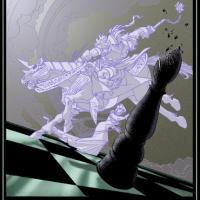
Up a Piece in the Endgame
Last week we explored strategies for winning with an extra rook. Today we will explore the situation when one side has an extra knight or bishop for a pawn, two pawns or for no compensation. There is a famous joke my coach likes to use that can be applied here: how does Capablanca convert an extra pawn? - He waits until the opponent blunders the second pawn. While we can wait for the second piece to be sacrificed/blundered by the opponent, having an extra piece is enough for a win in most situations. There are several typical plans that work in almost all endgames with an extra piece. These ideas for the attacking side include:
- trading pieces,
- activating the king,
- blocking the opponent's passed pawns,
- having patience,
- attacking and picking off the opponent's pawns,
- and promoting our own pawns.
Most of the ideas mentioned here we will explore with the following examples.
In the first position white is up a piece and black has no apparent compensation. There is still work to be done to win this winning endgame. Observe white's masterful plan of the piece conversion where he started off by exchanging bishops as it would weaken black's defensive potential. Secondly, he tied the black king to the b-pawn and positioned the knight ideally on the central d4-square. And lastly, he activated the king while slowly pushing the kingside pawns and eventually winning black pawns there because black's king was stuck on the queenside.
In the next example the rooks are still present on the board but this time it is black who is up a knight. Black starts off with a strategy of occupying the open file and exchanging rooks. White cannot really avoid the rook exchange because else the black rook gets to the 2nd-rank, where it would be monstrous. Despite the rook exchange white managed to preserve the bishop, which is helpful in defense. Black placed the bishop and the knight in a way so they defend the pawn minority on the kingside. Then she brought her king to the queenside and with the help of the king managed to exchange the bishops. White could have put up a better defense by getting the king to the center but instead white put the king on h2 trying to break through with h4.
While the first two examples were more or less straight-forward, the following example is particularly interesting when exploring the defensive possibilities that white has. After all white has two pawns for the bishop with all the pawns on the same side, how hard can it be to draw. Black correctly decided to exchange the knights, which white should have declined. After the knight exchange white could have defended with staying solid and trying to keep the position together. Instead, white committed a big mistake by letting the opponent fix his pawns on the same color as the opponent's bishop. This made the pawns weaknesses and eventually the d4-e3-f4 complex fell. Observe how black got to the e4-square with the help of zugzwang ideas.
The main feature of the last example is the idea of counterplay. Black is up a piece but the bishop on b8 is passive and white has more space. The only real weakness in white's camp is the f3-pawn. Black correctly builds his plan around exploiting this weakness. However, for a moment he forgets to keep an eye on white's b-pawn, which could have ended up in a loss instead of win. After white passes by this golden opportunity, black exchanges the bishop for the knight and queens the f-pawn.
Winning with an extra piece can be challenging especially under time trouble, this is why it is important to have sharp technique in order to convert the material advantage into a point. The strategies of piece exchanges, king activity, blockade of the opponent's passed pawns and attention to counterplay can simplify the realization process and lead to overall better endgame technique. Next week's article will explore more ideas and strategies in the situations when one side has extra material in the endgame.






